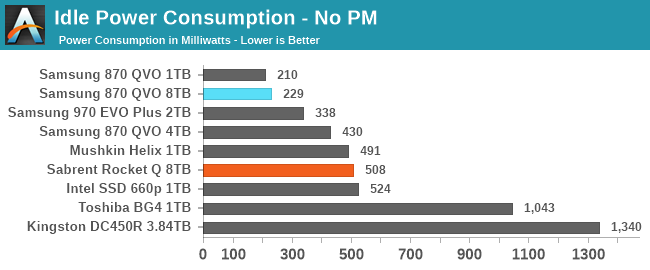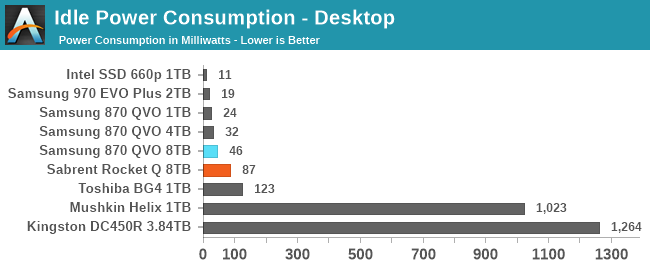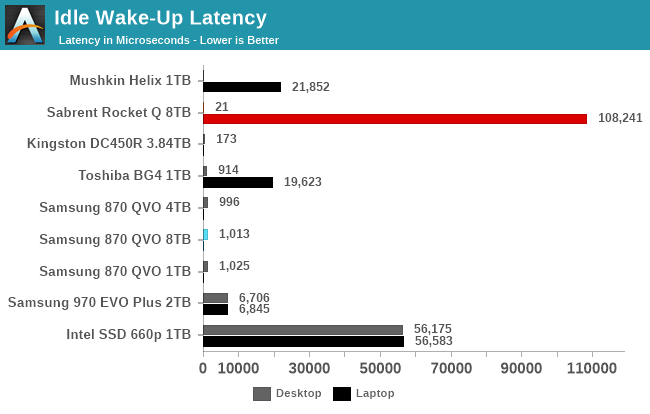QLC Goes To 8TB: Samsung 870 QVO and Sabrent Rocket Q 8TB SSDs Reviewed
by Billy Tallis on December 4, 2020 8:00 AM ESTPower Management Features
Real-world client storage workloads leave SSDs idle most of the time, so the active power measurements presented earlier in this review only account for a small part of what determines a drive's suitability for battery-powered use. Especially under light use, the power efficiency of a SSD is determined mostly be how well it can save power when idle.
For many NVMe SSDs, the closely related matter of thermal management can also be important. M.2 SSDs can concentrate a lot of power in a very small space. They may also be used in locations with high ambient temperatures and poor cooling, such as tucked under a GPU on a desktop motherboard, or in a poorly-ventilated notebook.
| Sabrent Rocket Q 8TB NVMe Power and Thermal Management Features |
|||
| Controller | Phison E12S | ||
| Firmware | RKT30Q.2 (ECFM52.2) | ||
| NVMe Version |
Feature | Status | |
| 1.0 | Number of operational (active) power states | 3 | |
| 1.1 | Number of non-operational (idle) power states | 2 | |
| Autonomous Power State Transition (APST) | Supported | ||
| 1.2 | Warning Temperature | 75°C | |
| Critical Temperature | 80°C | ||
| 1.3 | Host Controlled Thermal Management | Supported | |
| Non-Operational Power State Permissive Mode | Supported | ||
The Sabrent Rocket Q claims support for the full range of NVMe power and thermal management features. However, the table of power states includes frighteningly high maximum power draw numbers for the active power states—over 17 W is really pushing it for a M.2 drive. Fortunately, we never measured consumption getting that high. The idle power states look typical, including the promise of quick transitions in and out of idle.
| Sabrent Rocket Q 8TB NVMe Power States |
|||||
| Controller | Phison E12S | ||||
| Firmware | RKT30Q.2 (ECFM52.2) | ||||
| Power State |
Maximum Power |
Active/Idle | Entry Latency |
Exit Latency |
|
| PS 0 | 17.18 W | Active | - | - | |
| PS 1 | 10.58 W | Active | - | - | |
| PS 2 | 7.28 W | Active | - | - | |
| PS 3 | 49 mW | Idle | 2 ms | 2 ms | |
| PS 4 | 1.8 mW | Idle | 25 ms | 25 ms | |
Note that the above tables reflect only the information provided by the drive to the OS. The power and latency numbers are often very conservative estimates, but they are what the OS uses to determine which idle states to use and how long to wait before dropping to a deeper idle state.
Idle Power Measurement
SATA SSDs are tested with SATA link power management disabled to measure their active idle power draw, and with it enabled for the deeper idle power consumption score and the idle wake-up latency test. Our testbed, like any ordinary desktop system, cannot trigger the deepest DevSleep idle state.
Idle power management for NVMe SSDs is far more complicated than for SATA SSDs. NVMe SSDs can support several different idle power states, and through the Autonomous Power State Transition (APST) feature the operating system can set a drive's policy for when to drop down to a lower power state. There is typically a tradeoff in that lower-power states take longer to enter and wake up from, so the choice about what power states to use may differ for desktop and notebooks, and depending on which NVMe driver is in use. Additionally, there are multiple degrees of PCIe link power savings possible through Active State Power Management (APSM).
We report three idle power measurements. Active idle is representative of a typical desktop, where none of the advanced PCIe link power saving features are enabled and the drive is immediately ready to process new commands. Our Desktop Idle number represents what can usually be expected from a desktop system that is configured to enable SATA link power management, PCIe ASPM and NVMe APST, but where the lowest PCIe L1.2 link power states are not available. The Laptop Idle number represents the maximum power savings possible with all the NVMe and PCIe power management features in use—usually the default for a battery-powered system but not always achievable on a desktop even after changing BIOS and OS settings. Since we don't have a way to enable SATA DevSleep on any of our testbeds, SATA drives are omitted from the Laptop Idle charts.
Note: Last year we upgraded our power measurement equipment and switched to measuring idle power on our Coffee Lake desktop, our first SSD testbed to have fully-functional PCIe power management. The below measurements are not a perfect match for the older measurements in our reviews from before that switch.



The Samsung 870 QVO SSDs have lower active idle power consumption than the NVMe competition, though our measurements of the 4TB model did catch it while it was still doing some background work. With SATA link power management enabled the 8TB 870 QVO draws more power than the smaller models, but is still very reasonable.
The Sabrent Rocket Q's idle power numbers are all decent but not surprising. The desktop idle power draw is significantly higher than the 49mW the drive claims for power state 3, but it's still only at 87mW which is not a problem.

The Samsung 870 QVO takes 1ms to wake up from sleep. The Sabrent Rocket Q has almost no measurable wake-up latency from the intermediate desktop idle state, but takes a remarkably long 108ms to wake up from the deepest sleep state. This is one of the slowest wake-up times we've measured from a NVMe drive and considerably worse than the 25ms latency the drive itself promises to the OS.










150 Comments
View All Comments
shabby - Friday, December 4, 2020 - link
Go home qlc ssd manufacturers, you're drunk!Oxford Guy - Friday, December 4, 2020 - link
The market doesn't care what we want. It's driven by the manufacturers. That's the way most of tech is because of duopoly, triopoly power and the high cost of owning fabs. They get to dictate to us which is not the way consumerist capitalism is supposed to work.Oxford Guy - Friday, December 4, 2020 - link
There is also consumer ignorance. Go to a site that pushes product, like slickdeals, and you won't find the type of NAND listed in the listing for their SSD "deals". Everything is just an "SSD". Manufacturers are counting on consumer ignorance.Zim - Saturday, December 5, 2020 - link
Not true. Every one of those deals has people saying no to QLC. People still buy it because it's cheap.SirDragonClaw - Saturday, December 5, 2020 - link
Not true. 99.9% of people wouldn't even know what QLC means.ahtoh - Sunday, December 6, 2020 - link
Not true. I'd say 50% at least. People who buy SSDs (or parts in general) are more educated and probably know what they're doing.s.yu - Sunday, December 6, 2020 - link
"Parts"Ah that actually makes it sound pretty sophisticated :)
at_clucks - Monday, December 7, 2020 - link
50% of people know what QLC means? Is that a joke? 50% of ATers don't understand what that means. Most consumers who even heard of the term think it's just another type of LC, the more LCs the better right? No, almost no consumer knows what that means, it's a tech spec, they may know it's not the best out there but that's it But if the price is good they won't care.Product listings are marketing fluff and BS sprinkled with plenty of concepts no regular user will even understand because they sound fancy (like TWD and ECC), they will list stuff that the average consumer can understand and relate to - capacity, speed (lots of megabytes per second, thousands of them, eye catchy), and maybe the interface because they have to (again, in an eye catching way like "SATA 6.0 Gb/s"). Even if there is a Q in the product model almost nobody cares about that.
Search for QVO on Amazon and you'll see stuff like "RELIABLE AND SUSTAINABLE: The capacity of the 8TB 870 QVO increases reliability up to 2,880 TBW using a refined ECC algorithm for stable performance".
DigitalFreak - Monday, December 7, 2020 - link
Market these "Q"LC drives to Trump supporters and watch them fly off the shelves.peevee - Wednesday, December 9, 2020 - link
Oh, you gamer kidding are so smart and sophisticated, you even know the sacred secret of what QLC means! Do you know what 2+2 is? Then you deserve the Fields medal!We, engineers with decades of experience engineering this world, who thought that exactly 0 consumer applications and not more than 1% of enterprise applications require sustained write speeds over 300MB/s, bow before you!
Don't forget to ask for extra tip next time you serve me coffee.